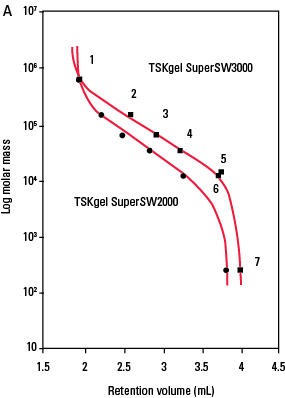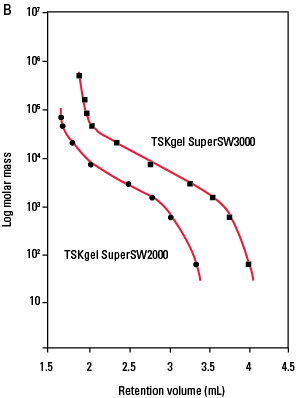TSKgel® SuperSW Columns for Higher Sensitivity Protein Analysis
TSKgel® SuperSW columns, introduced in 1997, have become synonymous with analyzing protein molar masses in the emerging field of biotechnology.
TSKgel® SuperSW columns contain smaller particles than TSKgel® SWXL columns; 4 micron versus 5 micron. In addition, the column internal diameter has been reduced from 7.8 mm ID to 4.6 mm ID to provide higher sensitivity in sample-limited cases and to cut down on solvent use.
|
HPLC System Requirements
It is important to employ an HPLC system that is optimized with regards to extra-column bandbroadening to take full advantage of the high column efficiency that can be obtained on TSKgel® SuperSW columns. See Separation Report 95 for recommendations.
Calibration Curves
The figures show the calibration curves for globular proteins (A) and for polyethylene oxides and glycols (B) for TSKgel® Super SW columns.

|
 |
Columns:
Mobile phase:
Flow rate:
Detection:
Samples: |
TSKgel® SuperSW columns,
4.6 mm ID × 30 cm
0.2 mol/L phosphate buffer, pH 6.7
0.35 mL/min
UV @ 280 nm
standard proteins (5 µL, 0.1 g/L each)
1. thyroglobulin
2. g-globulin
3. bovine serum albumin
4. β-lactoglobulin
5. lysozyme
6. cytochrome C
7. glycine tetramer |
|
Columns:
Mobile phase:
Flow rate:
Detection:
Temperature:
Samples: |
TSKgel® SuperSW columns,
4.6 mm ID × 30 cm
0.05% sodium azide aqueous solution
0.35 mL/min
RI
25 °C
polyethylene oxides (PEO) standards polyethylene glycols (PEG) standards,
(5 µL) |
|
Tables within the tabs below summarize the molar mass ranges for the TSKgel® SuperSW2000 and SuperSW3000 columns for globular proteins, polyethylene oxides and dextrans that can, at least partially, access the particle pores.
|